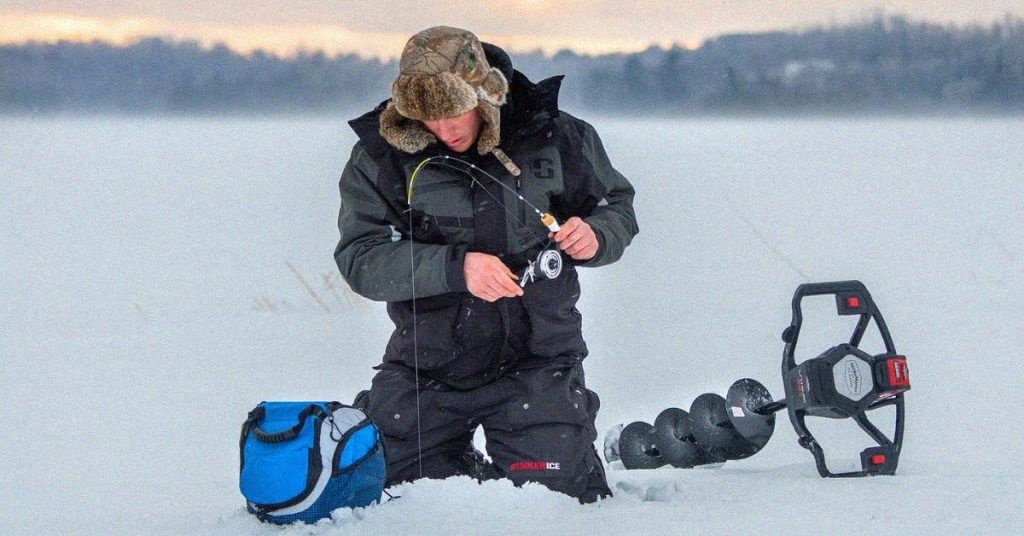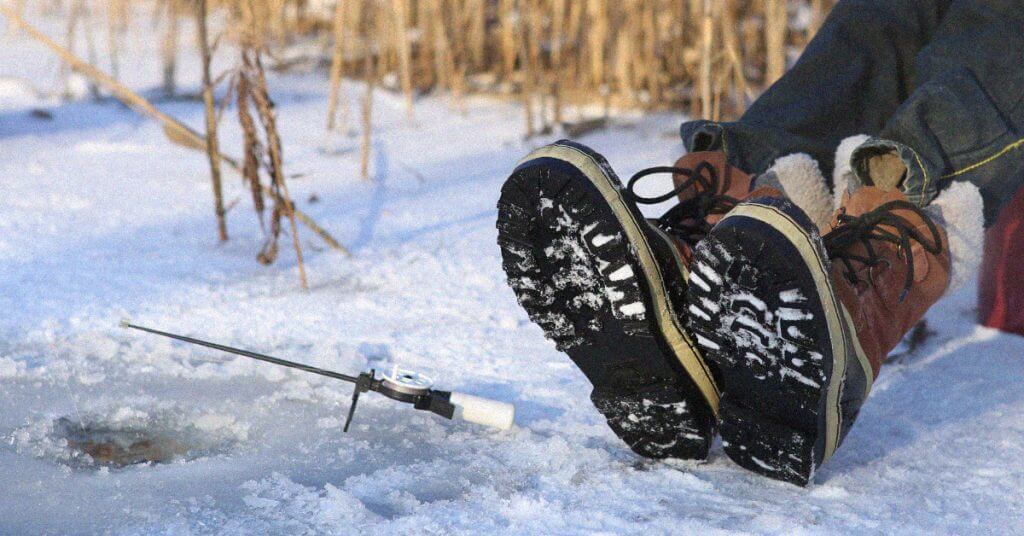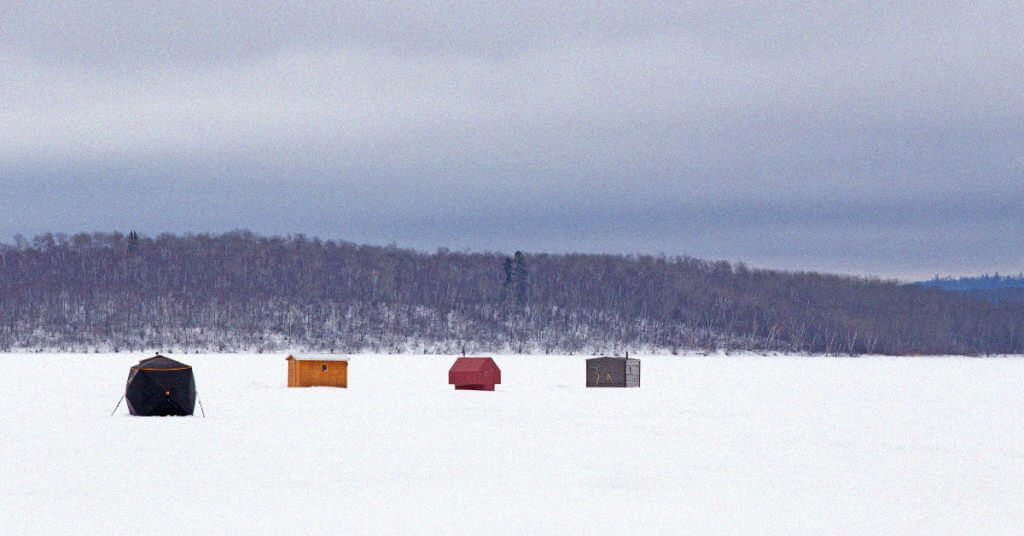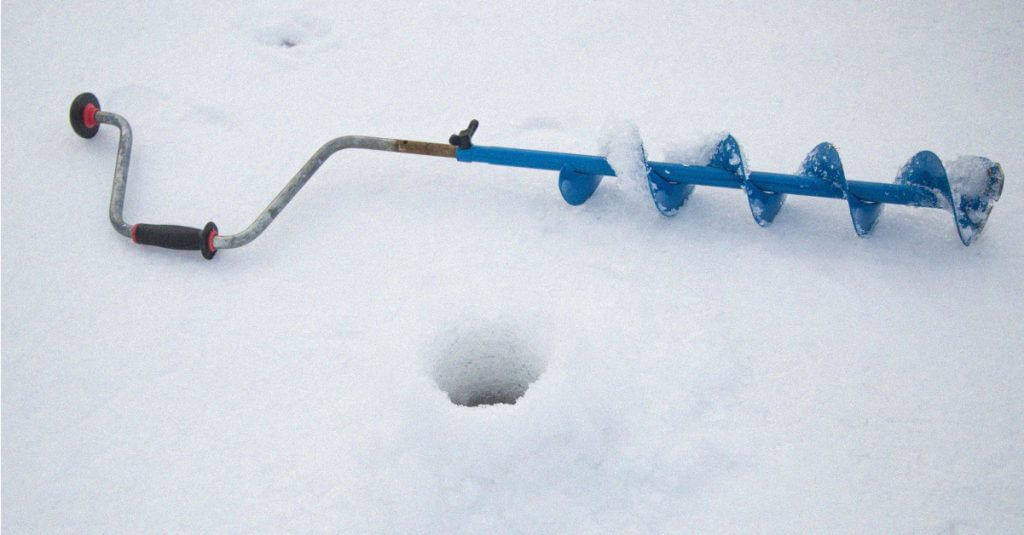The key to ice fishing is understanding the similarities and differences from warm weather fishing. Scouting and tracking fish is nearly the same whether it’s 90 or 25 degrees. The intimidation factor is what keeps people off the ice.
I want you to know, there’s nothing to be afraid of. I stepped foot on the ice for the first time almost 20 years ago and I’ve never looked back. I’ve never fallen through the ice or even had a scare.
As long as you know what you’re in for, you prepare, and you come equipped with the right gear, ice fishing isn’t hard.
This guide is full of ice fishing tips, gear recommendations, and helpful how-tos. Let’s get into it.
What Is Ice Fishing?
Ice fishing is the practice of catching fish through a hole on a lake or pond that has frozen over. Primitive methods such as trapping and jigging are implemented and ice fishing requires cold weather gear and plenty of preparation.
Ice Fishing for Beginners: The Basics
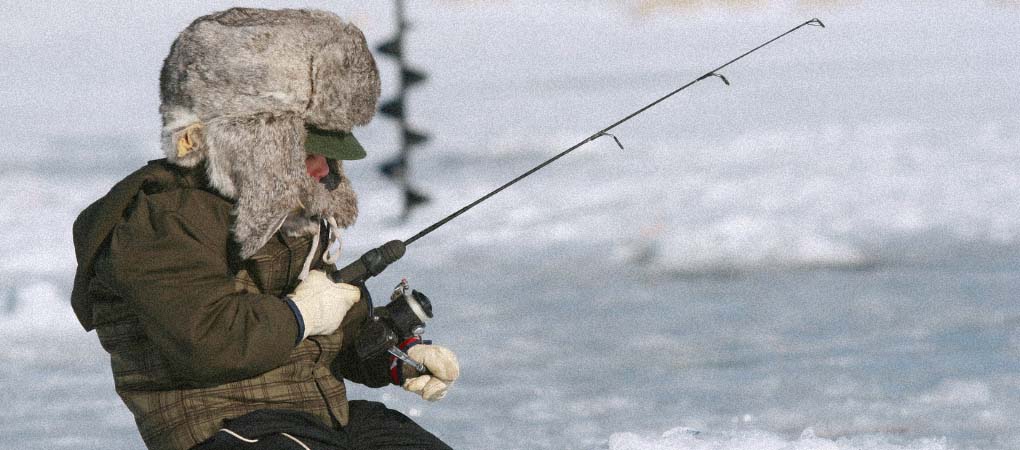
Now that you know what ice fishing is, let’s start this ice fishing guide by discussing some ice fishing basics. The key to ice fishing for beginners is to get all the information you can and just run with it.
Don’t think too hard, don’t dwell for weeks, just gather the basics and get out there and learn from experience. Here’s everything you need to know.
Why Ice Fish?
You want to know something funny? This question gets asked a lot more than you think. There are even people I fish with regularly who will ask me why I ice fish.
My answer is always the same.
I ice fish because it’s different. Ice fishing is a nice break from typical fishing. It requires a different approach, different equipment, different conditions, and a totally unique set up. There are other lakes I get to try out and unique types of fish that I can target that I couldn’t during the warm weather. I can still ice fish for bass too!
If you’re feeling like you’re starting to fall “out of love” with the sport or you’re looking for a new and exciting challenge, ice fishing might be the way to go.
Where To Ice Fish and How to Find Fish Ice Fishing
As a warm weather bass angler, how do you find a spot to fish when the whole lake is frozen over? That’s the challenge that a lot of people will experience their first time on the hard water.
Do you go out there and start drilling wherever and hope to strike gold? Is there a process to determine the best spots to fish? Can technology help?
When it comes to ice fishing, you’ll apply a lot of the same principles you would during the warm weather season. You’re still looking for:
- Drop-offs
- Structure
- Vegetation
The same rules apply. The only problem is, these things are a little harder to find when there’s ice covering everything. So, you have a few options.
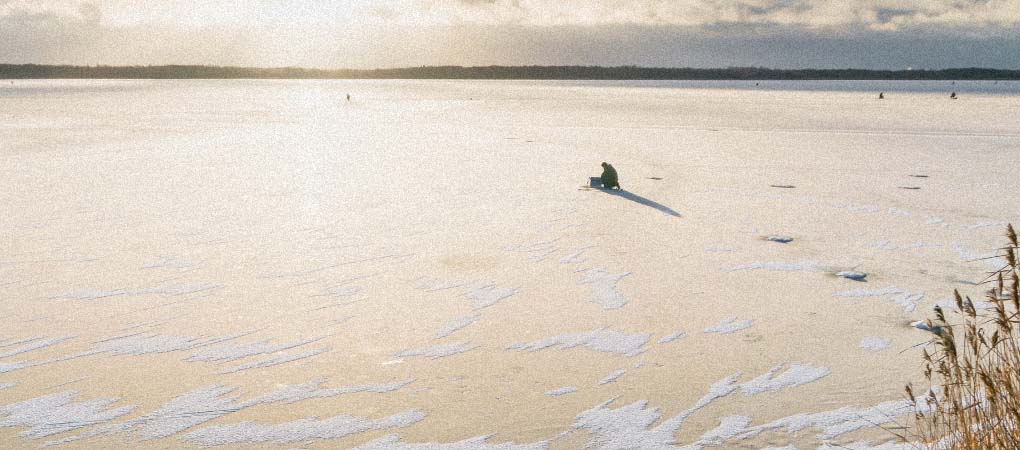
Option one is to fish familiar water. Your first time ice fishing shouldn’t be to a lake you’ve never fished before. You’ll want to go somewhere you’ve fished a few times because you’ll know where the fish hide out, where the stumps and docks are, and any access points.
Option two is to have some technology. If you have an ice fishing fish finder it will be a lot easier for you. Using the GPS and navigation features will display contours of the bottom. This will help you figure out where the drop-offs are so you can drill in those areas.
Option three is to drill a hole and hope for the best. If you’re not fishing familiar water and you don’t have a fish finder or flasher then you’ll have to wing it. Fish the hole for 30 minutes or so and if you’re not getting any action, move on.
When To Ice Fish?
The best time to ice fish is right around sunrise and right before sunset. This is when the fish are most active so they’re most likely to feed heavily during this time. Bear in mind that you don’t need to hit the lake right before sunrise. They’ll be active for the first few hours after sunrise and the last few hours before sunset.
Sunrise
If you’re like me, you prefer fishing in the morning. There’s something exciting about getting up before the sun, having all your gear packed from the night before, and grabbing a coffee on the way.
You’ll want to arrive a little before sunrise so you have time to navigate the ice, find your spot, drill your hole, and get yourself situated. This will allow you to cut off the fish on their route to the feeding areas. You don’t want to be moving around, banging things, and drilling holes while the fish are relocating because it will scare them away.
Sunset
Sunset is a popular time to ice fish for most people because plankton and other microorganisms make their way to the top when the light isn’t shining on the water. Fish like to feed during this time because it’s easier for them and it’s still bright enough for them to see.
Keep in mind that fishing into the dark is also a possibility. Make sure you have ice fishing cleats and bibs to prevent you from falling or getting too cold out there at night.
Best Time to Ice Fish: By Species
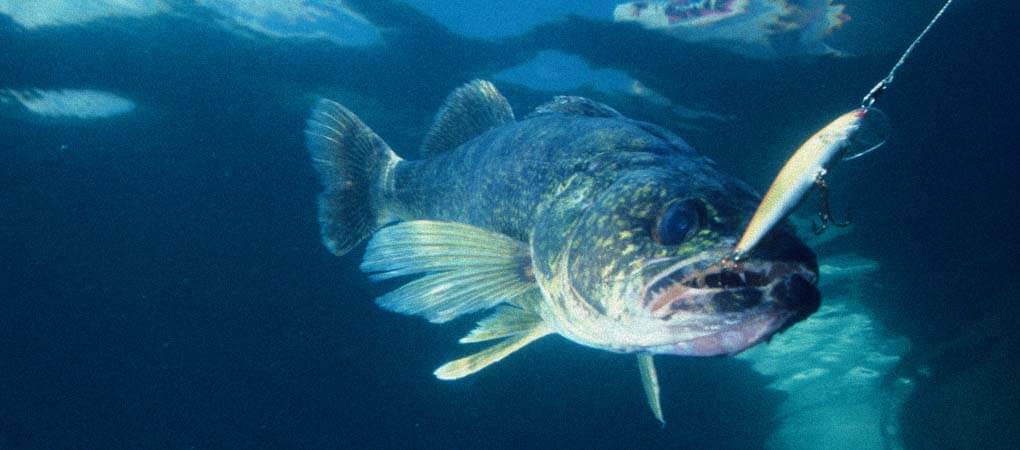
For all of you out there targeting specific species, here are the best times to fish based on the type of fish you’re after:
Perch – Perch are one of the easiest fish to catch and can be caught throughout the day. You’ll have the most success around sunrise and sunset though.
Trout – The best time to catch trout is in the morning because they can’t see well in the dark. You’ll find them in the shallow water and be sure to get to the lake early because too much noise will scare this finicky fish away.
Walleye – Walleye is one of the most targeted ice fishing species and the best time to catch them is in the evening. These guys have excellent night vision and they feed during periods of low light so expect to fish into the dark if you’re after walleye. When the panfish, bass, and trout have gone away, these fish will continue feeding.
Pike – Pike is another popular ice fishing species and they feed most when the water temperatures are coldest. This means that you’ll have the best chance of catching pike in the early morning right around sunrise.
How to Drill an Ice Fishing Hole?
One primary area that makes ice fishing different from the rest is the fact that you’re fishing through a small hole. There’s no casting involved and the methods you can use are pretty limited.
To wet your line, you’ll need to learn how to drill an ice fishing hole.
You need an ice fishing auger to do this. Choosing the best ice fishing auger will require you to understand the various options:
- Gas-powered auger
- Electric auger
- Hand auger
These are the three most popular options. Let’s break each of them down.
Gas Auger
A gas auger operates similar to a gas-powered weed whacker. It has a small reservoir that you’ll fill with gas or a gas/kerosene mixture. You’ll use a pull string or a push to start operation to get the auger started.
These are bulky, heavy, and temperamental based on the temperature. If it’s really cold you’ll have a hard time getting it started but they are the beasts of the ice and will cut through nearly anything.
Electric Auger
I’m finding that these augers are becoming the more favorable choice because they’re potentially 20+ pounds lighter in some cases. It makes your ice fishing sled a lot lighter and they’re less likely to give you trouble.
The only thing you need to worry about with electric augers is the obvious issues you run into when using something that is battery-powered. The more you use it, the faster you’re going to chew up your battery life. Always have a back up.
Hand Auger
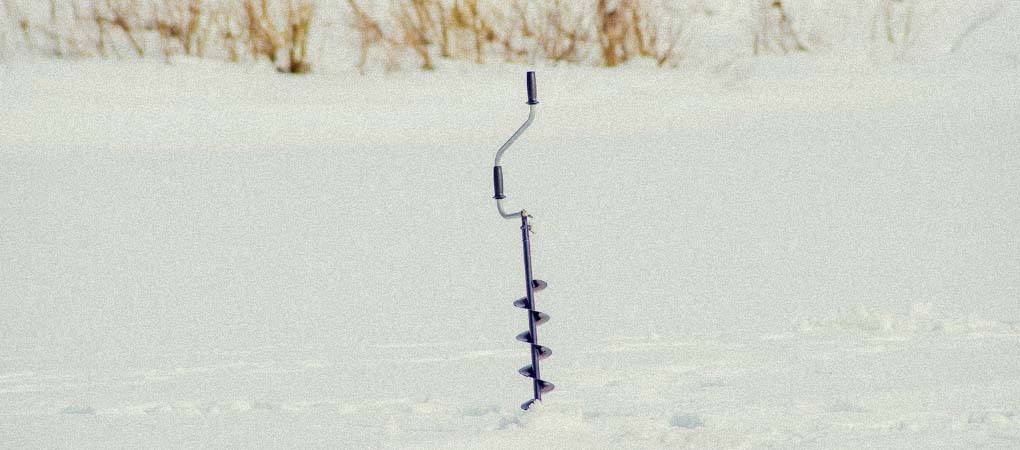
If you’re a glutton for punishment, you can use a hand auger. You need to make sure the blades are razor sharp.
[Here are step-by-step instructions on sharpening ice auger blades]
You manually crank the auger. You’ll work up a heck of a sweat and it might take you 20 minutes to drill through but you’ll get there eventually. I don’t recommend this though because you’re likely going to drill multiple holes, especially when you’re first starting out. Do yourself a favor and drop the money to get an electric auger.
Tips for Drilling an Ice Fishing Hole
Now let’s talk about specific hole drilling steps. You’ve got your auger, you’re ready to drill the hole, now what?
1. Mark the area you want to drill with an ice chisel. You can chip away at the ice to give your auger a place to start so it doesn’t slide around. A lot of augers come with flat bases to make them more manageable.
2. Grip the ice with a durable pair of ice fishing boots otherwise the auger can send you spinning with it.
3. Press down on the hole you created and hit the throttle. Don’t press too hard, let the auger do the work. Pressing harder won’t drill the hole any faster and you’re only putting more pressure on the machine at that point.
4. Once your hole is drilled, remove the blades and clean the hole up with your chisel again. I also recommend having a skimmer to clean the hole out if it slushes over.
Best Ice Fishing Techniques: How to Ice Fish?
One thing I find so interesting about ice fishing is the fact that we do it the same as it’s been done for hundreds of years. If you take away the fish finders, ice fishing flashers, headlamps, and cameras; it’s all the same.
You essentially have two ways to fish your ice fishing hole. You can use a tip-up or you can jig using an ice fishing rod. Let’s break each technique down:
Tip-Ups
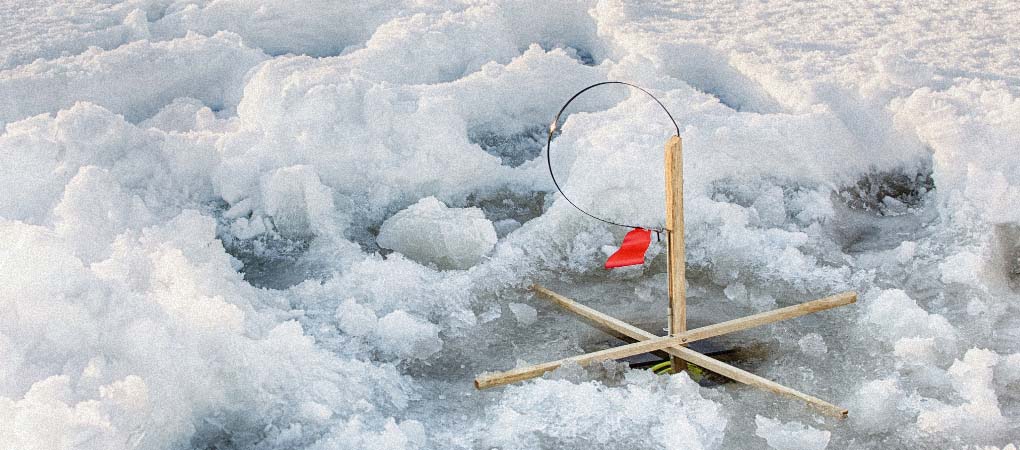
A tip-up is an ice fishing trap. You’ll set a wood or plastic platform over your hole with your hole suspended in the water below. Most anglers use live bait like minnows and shiners for this because the fish can still swim while it’s hooked.
When a fish comes along and strikes the bait, it will project a flag up in the air alerting you that there is a fish on. You’ll run over to the tip-up and manually pull the line out of the water by hand.
This type of “bare-knuckle” battling with the fish is really primitive and exciting. It can be challenging but there are few feelings like it.
Jigging
Typically if you’ve found a honey hole (hole that is catching a lot of fish) you’ll want to actively fish that hole using a jigging technique. You’ll let the lure fall for a few seconds, tighten your line, and twitch the rod tip up and down for a few seconds, then repeat the process.
Using a spring bobber is a great way to maximize your time jigging. A spring bobber goes on the end of your rod and your line is fed through it. It makes it much easier to pick up on small nibbles from crappie, northern pike, and whatever else you’re targeting.
Having an ice fishing chair is an important piece of equipment because it will ensure you stay comfortable during long periods of jigging over the hole. Kneeling or sitting on the ice is not a smart option.
Best Ice Fishing Tackle
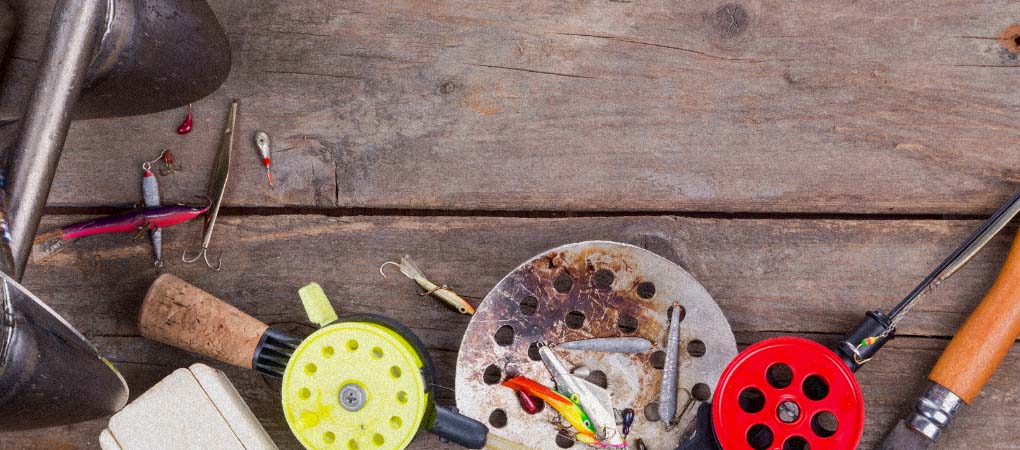
The best ice fishing lures can be broken down into a few categories. You’ve got jigs, spoons, jerkbaits, and soft plastics. Those are the four most popular options for cold weather fishing because they can be worked slowly.
Of course, the type of lure you use should depend on what type of fish you’re targeting. If you’re after panfish, go with a small jig like a whistler or undersized rapala.
If you’re after walleye or pike, you can size up your jigs and spoons a little. Go with a Rapala Super Shad or an Acme Kastmaster. These offer great action for fish with decent to good visibility in the water.
Best Ice Fishing Bait
Live bait will serve as a better option, especially for beginner ice anglers. You don’t have to worry as much about the presentation and the baits are sized naturally to attract the fish you want. Some of the most popular options are:
- Minnows
- Nightcrawlers
- Wax worms
You should be able to find these in any pro shop or bait store near you. The nightcrawlers and wax worms are great options because you can still use them with the tungsten jig head as well or in conjunction with various ice fishing lures. Rigging a few hooks with some worms will help make the strike more desirable.
Essential Ice Fishing Equipment
As you can surely tell by this point, ice fishing isn’t cheap. There are a lot of things you need to buy just to get started. Many of the most important pieces of equipment, we’ve already talked about but here are a few more things you’re going to need.

Ice Fishing Rod
You’ll want to have a dedicated ice fishing rod because these are different from your typical rod. They’re about three to four feet in length to make it easier to fish inside of an ice fishing shelter. They’re ultralight and designed for slow jigging with suspended lures.
Ice Fishing Reel
I suggest sticking with a typical spinning ice fishing reel because inline reels just add something new for you to learn that you don’t need. The Pflueger President and Abu Garcia ICEMAX are two popular options. You can also purchase ice fishing rod and reel combos to make things simpler.
Ice Fishing Gloves
You don’t want just any gloves because they’ll either impede your ability to fish or they won’t be warm enough to prevent your fingers from freezing. Ice fishing gloves are designed to flip open so you can rig your baits but also close up to keep you warm during periods of inactivity.
Ice Fishing FAQs
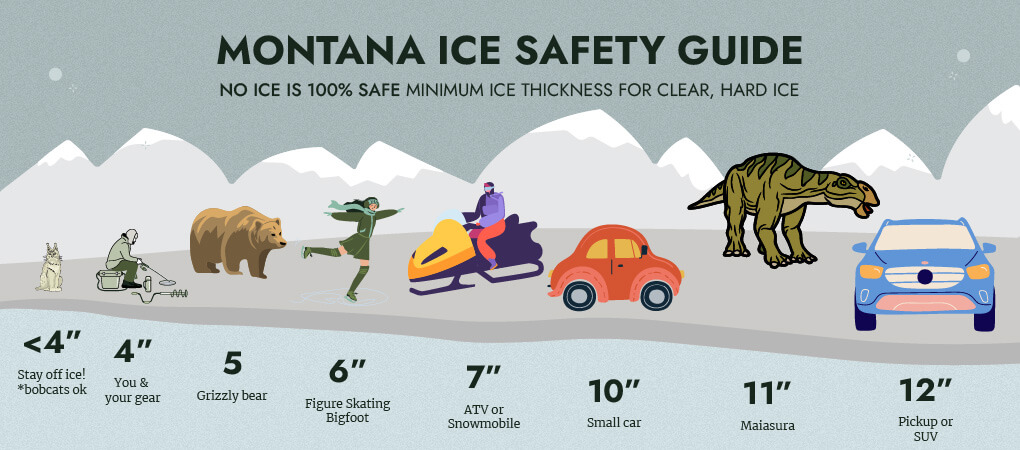
Here are some of the most frequently asked questions about ice fishing:
How thick should ice be for ice fishing?
Safety is very important so it’s recommended that the ice be at least four inches thick to withstand any person. Pay attention to moving water beneath the ice because that will indicate thinner ice.
If you’re driving a snowmobile or ATV on the ice, you’ll want it to be at least five or six inches thick.
What month is best for ice fishing?
The best month for ice fishing really depends on where you live. Certain states like Minnesota and Michigan have a much longer ice fishing season than states like Ohio and Pennsylvania.
The northern states can ice fishing from January-March while other states may only be able to ice fish in February.
What line should I use for ice fishing?
The best ice fishing line is weather-rated for freezing temperatures and low-visibility in the clear water. Fluorocarbon leaders are popular in ice fishing but it’s important that the line has low memory so it doesn’t freeze in the shape of your spool when it’s really cold.
Do you need a fishing license for ice fishing?
Yes, you’ll need a fishing license to fish public property and there are catch and release seasons as well so make sure you study up on your local DCNR website to determine what’s legal to keep.
Final Thoughts
I hope you get something out of this guide and feel more equipped to take on the exciting world of ice fishing. If you’ve never been ice fishing before, you have nothing to worry about. Make sure the ice is thick enough and ensure you have all the necessary ice fishing gear.
I highly suggest ice fishing with a buddy for the first time. Find someone with experience who can take you out and show you the ropes. We all had someone teach us how to fish for bass but ice is a whole different ball game. Have fun, stay safe, and enjoy!

